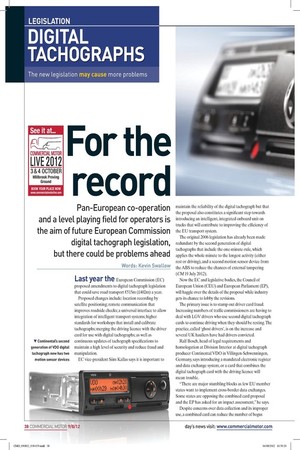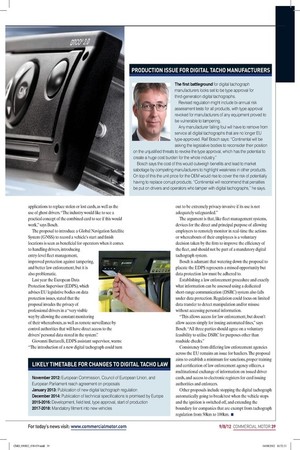For the record
Page 28

Page 29

If you've noticed an error in this article please click here to report it so we can fix it.
Pan-European co-operation and a level playing field for operators is the aim of future European Commission digital tachograph legislation, but there could be problems ahead
Words: Kevin Swallow
Last year the European Commission (EC) proposed amendments to digital tachograph legislation that could save road transport €515m (£402m) a year.
Proposed changes include: location recording by satellite positioning; remote communication that improves roadside checks; a universal interface to allow integration of intelligent transport systems; higher standards for workshops that install and calibrate tachographs; merging the driving licence with the driver card for use with digital tachographs; as well as continuous updates of tachograph speciications to maintain a high level of security and reduce fraud and manipulation.
EC vice-president Siim Kallas says it is important to maintain the reliability of the digital tachograph but that the proposal also constitutes a signiicant step towards introducing an intelligent, integrated onboard unit on trucks that will contribute to improving the eficiency of the EU transport system.
The original 2006 legislation has already been made redundant by the second generation of digital tachographs that include the one-minute-rule, which applies the whole minute to the longest activity (either rest or driving), and a second motion sensor device from the ABS to reduce the chances of external tampering (CM 19 July 2012).
Now the EC and legislative bodies, the Council of European Union (CEU) and European Parliament (EP), will haggle over the details of the proposal while industry gets its chance to lobby the revisions.
The primary issue is to stamp out driver card fraud. Increasing numbers of trafic commissioners are having to deal with LGV drivers who use second digital tachograph cards to continue driving when they should be resting. The practice, called ‘ghost drivers’ , is on the increase and several UK hauliers have had drivers convicted. Ralf Bosch, head of legal requirements and homologation at Division Interior at digital tachograph producer Continental VDO in Villingen-Schwenningen, Germany, says introducing a mandated electronic register and data exchange system, or a card that combines the digital tachograph card with the driving licence will mean trouble.
“There are major stumbling blocks as few EU member states want to implement cross-border data exchanges. Some states are opposing the combined card proposal and the EP has asked for an impact assessment,” he says. Despite concerns over data collection and its improper use, a combined card can reduce the number of bogus applications to replace stolen or lost cards, as well as the use of ghost drivers. “The industry would like to see a practical concept of the combined card to see if this would work,” says Bosch.
The proposal to introduce a Global Navigation Satellite System (GNSS) to record a vehicle’s start and inish locations is seen as beneicial for operators when it comes to handling drivers, introducing entry-level leet management, improved protection against tampering, and better law enforcement, but it is also problematic.
Last year the European Data Protection Supervisor (EDPS), which advises EU legislative bodies on data protection issues, stated that the proposal invades the privacy of professional drivers in a “very visible way by allowing the constant monitoring of their whereabouts, as well as remote surveillance by control authorities that will have direct access to the drivers’ personal data stored in the system”.
Giovanni Buttarelli, EDPS assistant supervisor, warns: “The introduction of a new digital tachograph could turn out to be extremely privacy-invasive if its use is not adequately safeguarded.” The argument is that, like leet management systems, devices for the direct and principal purpose of allowing employers to remotely monitor in real-time the actions or whereabouts of their employees is a voluntary decision taken by the irm to improve the eficiency of the leet, and should not be part of a mandatory digital tachograph system.
Bosch is adamant that watering down the proposal to placate the EDPS represents a missed opportunity but data protection law must be adhered to.
Establishing a law enforcement procedure and exactly what information can be assessed using a dedicated short-range communication (DSRC) system also falls under data protection. Regulation could focus on limited data transfer to detect manipulation and/or misuse without accessing personal information.
“This allows access for law enforcement, but doesn’t allow access simply for issuing automated ines,” says Bosch. “All three parties should agree on a voluntary feasibility to utilise DSRC for purposes other than roadside checks.” Consistency from differing law enforcement agencies across the EU remains an issue for hauliers. The proposal aims to establish a minimum for sanctions, proper training and certiication of law enforcement agency oficers, a multinational exchange of information on issued driver cards, and access to electronic registers for card issuing authorities and enforcers.
Other proposals include stopping the digital tachograph automatically going to break/rest when the vehicle stops and the ignition is switched off, and extending the boundary for companies that are exempt from tachograph regulation from 50km to 100km. ■
PRODUCTION ISSUE FOR DIGITAL TACHO MANUFACTURERS
The first battleground for digital tachograph manufacturers looks set to be type approval for third-generation digital tachographs.
Revised regulation might include bi-annual risk assessment tests for all products, with type approval revoked for manufacturers of any equipment proved to be vulnerable to tampering.
Any manufacturer falling foul will have to remove from service all digital tachographs that are no longer EU type-approved. Ralf Bosch says: “Continental will be asking the legislative bodies to reconsider their position on the unjustified threats to revoke the type approval, which has the potential to create a huge cost burden for the whole industry.” Bosch says the cost of this would outweigh benefits and lead to market sabotage by competing manufacturers to highlight weakness in other products. On top of this the unit price for the OEM would rise to cover the risk of potentially having to replace corrupt products. “Continental will recommend that penalties be put on drivers and operators who tamper with digital tachographs,” he says.
LIKELY TIMETABLE FOR CHANGES TO DIGITAL TACHO LAW
November 2012: European Commission, Council of European Union, and European Parliament reach agreement on proposals January 2013: Publication of new digital tachograph regulation December 2014: Publication of technical specifications is promised by Europe 2015-2016: Development, field test, type approval, start of production 2017-2018: Mandatory fitment into new vehicles









































